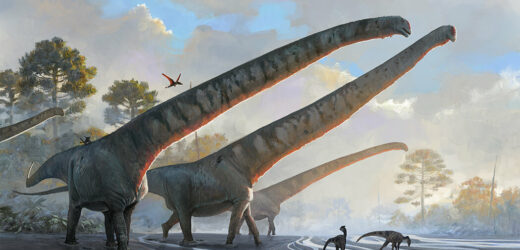Few creatures have pushed anatomy to its limits like sauropods. These supersized dinosaurs moved on pillar-like limbs that supported massive girth, wielded whip-like tails to ward off predators and used long necks to vacuum up foliage.
While this entire group of dinosaurs is commonly referred to as “long necks,” Mamenchisaurus, which roved around what is now China during the late Jurassic period, would have given other sauropods neck envy. In a study published Wednesday in the Journal of Systematic Paleontology, researchers estimate that Mamenchisaurus’s neck stretched to a length of nearly 50 feet. Longer than the average school bus, its neck is the longest estimated of any sauropod species. It may be the longest neck on an animal ever observed.
In 1987, paleontologists discovered the partial skeleton of a sauropod poking out of the rusty red sandstone of the dinosaur-rich Shishugou Formation in northwest China. The remains were fragmentary, consisting mostly of a lower jaw, bits of skull and a couple vertebrae, but they hinted at an enormous animal that thundered across marshy plains 162 million years ago alongside primitive tyrannosaurs.
Researchers named the dinosaur Mamenchisaurus sinocanadorum and connected it to several other long-necked sauropods from East Asia. But Mamenchisaurus’s true size remained an enigma. No other fossilized remains of the sauropod have been excavated, leaving scientists with only those couple vertebrae to examine.
Andrew Moore, a paleontologist at Stony Brook University who studies sauropod anatomy, said that this was the case for many of the largest dinosaurs. “What’s particularly tantalizing and frustrating is that oftentimes, the longest necks belong to the things that are the least known in the fossil record for the simple reason that it’s really hard to bury something that large,” Dr. Moore, who led the new study, said.
So he turned to the fossils of several close relatives of Mamenchisaurus, especially Xinjiangtitan, a slightly older sauropod discovered in northwest China in 2013. Remarkably, researchers unearthed Xinjiangtitan’s entire vertebral column. At nearly 44 feet long, it represents the longest complete neck in the fossil record.
“By using these more complete, but smaller specimens, we can scale up and make a pretty competent estimate of what Mamenchisaurus would have looked like,” Dr. Moore said.
After comparing Mamenchisaurus and Xinjiangtitan, Dr. Moore and his team concluded that Mamenchisaurus possessed a neck nearly 50 feet long. This would account for roughly half of its estimated total body length and is equivalent to just over eight giraffe necks stacked end-to-end.
To determine how Mamenchisaurus managed a neck as long as a semi-truck trailer, Dr. Moore and colleagues used a CT scanner to analyze the animal’s vertebrae. Instead of being stuffed with heavy marrow and tissue while the dinosaur was living, the interior of the sauropod’s vertebrae were filled with large air pockets similar to those found in modern birds like storks and swans. These empty pockets accounted for up to 77 percent of each bone’s volume, vastly decreasing the weight of Mamenchisaurus’s spine.
Cary Woodruff, a paleontologist at the Frost Science Museum in Miami who specializes in studying sauropods, said that lightening the neck’s load was essential for all sauropods. “Having such a long neck is a large weight that you have to position away from your body,” said Dr. Woodruff, who was not involved in the new study. “If you have to hold a hammer with your arm stretched out, your arm’s going to get tired pretty quick.”
Even though its vertebrae were hollow, Mamenchisaurus’s neck was far from frail. During the initial excavation, paleontologists uncovered a fossilized rod of bony tissue several feet long. It may have been a stiff extension of the vertebra, often called cervical ribs, that would have run the length of the neck, bolstering its lightweight bones like a brace. While this reduced the flexibility of its neck, these ribs helped keep the sprawling structure stable.
“Even though it had a lot of bones, it wasn’t like a snake where it could curl up back on itself,” Dr. Woodruff said. “It was basically like a rod.”
With its reinforced spine, Mamenchisaurus most likely kept its neck horizontal at a relatively shallow angle above the ground. But because of how long its neck was, it could still pick leaves off the tops of many trees. This may have helped the sauropod squeeze into a unique niche in an ecosystem that was probably crowded with other gigantic herbivores.
According to the researchers, several groups of sauropods appear to have evolved extremely long necks, which may have rivaled the crane-like projections of Mamenchisaurus.
“We don’t really know what the limits are, because they continue to push them as we make more and more discoveries,” Dr. Moore said. “Our default should always be to assume that there’s something larger out there.”
Source: Read Full Article


